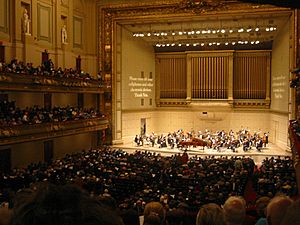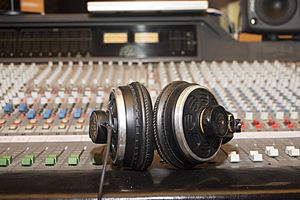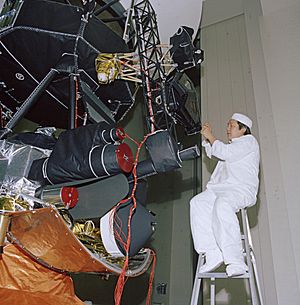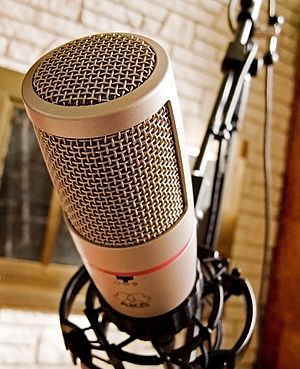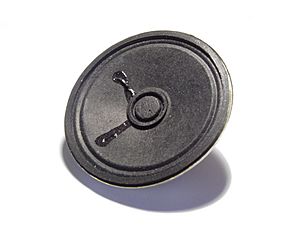Acoustics facts for kids
Acoustics is the science that studies sound. This includes sounds we can hear, plus sounds that are too high-pitched (called ultrasound) or too low-pitched (called infrasound) for human ears. All these are types of mechanical waves that travel through gases, liquids, and solids. A scientist who works with acoustics is called an acoustician. When acoustics is used in technology, it's known as acoustical engineering.
Hearing is super important for animals to survive. And human speech is a big part of our culture and how we've developed. That's why acoustics is used in so many areas of our lives! Think about music, medicine, how buildings are designed, making things in factories, and even in defense.
The word "acoustic" comes from the Greek word akoustikos. This means "of or for hearing" or "ready to hear." At first, acoustics was mostly about sounds we could hear. But scientists later started studying sounds that are too high or too low for us to hear. So, "ultrasonic" means very high-pitched sounds, and "infrasonic" means very low-pitched sounds. Now, the word "acoustic" covers all these sound ranges.
The study of acoustics looks at how mechanical waves and vibrations are made, how they travel, and how they are received.
Contents
History of Sound Science
People have been curious about sound for a very long time! Many books about music theory say that Pythagoras was the first person in the Western world to study how string lengths relate to how good sounds feel together (called consonance).
However, the Chinese were already using similar ideas around 3000 BC. They had a musical scale based on how strings vibrate. Like the Chinese, Pythagoras wanted to know why some musical sounds seemed to go together better than others. He found answers by looking at numbers that showed how different musical notes relate to each other on a vibrating string.
Aristotle (who lived from 384 to 322 BC) understood that sound happens when air squeezes together and spreads out. He said it was like air "falling upon and striking the air which is next to it." This is a great way to describe how sound waves move!
Around 20 BC, a Roman architect and engineer named Vitruvius wrote about how sound worked in theaters. He talked about things like how sounds can mix up, how echoes happen, and how sound can bounce around in a room (called reverberation). This was the start of architectural acoustics, which is about designing buildings for good sound.
During and after the Scientific Revolution, people learned a lot more about how sound works physically. Galileo (1564–1642) and Mersenne (1588–1648) both figured out the rules for vibrating strings. This finished what Pythagoras had started 2000 years before!
Between 1630 and 1680, many scientists, including Mersenne, successfully measured the speed of sound in air. Later, Isaac Newton (1642–1727) figured out how fast waves travel in solid materials. This was a very important discovery for understanding how sound moves through things.
In the 1700s, great mathematicians used new math tools to learn even more about how waves travel. In the 1800s, two very important people in acoustics were Helmholtz in Germany and Lord Rayleigh in England. Helmholtz studied how our bodies hear sound, and Lord Rayleigh made many discoveries about the physics of sound.
The 1900s saw a huge growth in using all this scientific knowledge in technology. One of the first big uses was Sabine's important work in architectural acoustics. Many other uses followed. For example, during World War I, underwater acoustics was used to find submarines.
Things like sound recording and the telephone changed society all over the world. With new electronics and computers, measuring and analyzing sound became much more accurate and detailed.
The very high-frequency range (ultrasonic) led to completely new uses in medicine and industry. New types of transducers (devices that make or receive sound energy) were invented and put to use.
Understanding Sound Frequency
Physicists and sound engineers often talk about sound in terms of its frequency. This is because our ears hear sounds differently based on their frequency. What we hear as "higher pitched" or "lower pitched" sounds are actually pressure vibrations that happen more or less often each second.
The whole range of sound frequencies can be split into three main parts: audio, ultrasonic, and infrasonic.
- The audio range is between 20 Hz and 20,000 Hz. This range is important because these are the frequencies that human ears can hear. It's used for things like talking and music.
- The ultrasonic range refers to very high frequencies: 20,000 Hz and higher. These sounds have shorter wavelengths, which means they can create clearer images. Medical uses like ultrasound scans and elastography (which checks how stiff tissues are) use the ultrasonic frequency range.
- On the other end, the lowest frequencies are called the infrasonic range. These frequencies can be used to study big natural events like earthquakes.
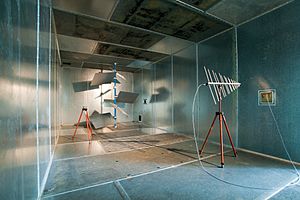
How Transducers Work in Acoustics
A transducer is a device that changes one type of energy into another. In acoustics, this usually means changing sound energy into electrical energy, or electrical energy back into sound. For almost all sound-related uses, you need some kind of acoustic transducer.
Examples of acoustic transducers include loudspeakers, microphones, hydrophones (which listen to sounds underwater), and sonar projectors. These devices take an electric signal and turn it into a sound pressure wave, or they take a sound wave and turn it into an electric signal.
A subwoofer, which makes very low-frequency sounds in speaker systems, is an electromagnetic device that acts as a transducer.
Images for kids
See also
 In Spanish: Acústica para niños
In Spanish: Acústica para niños


